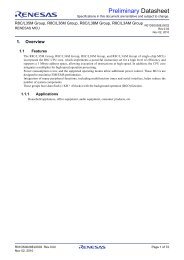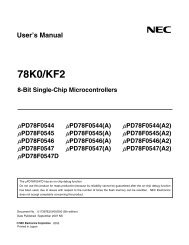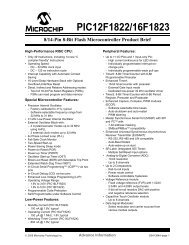xmega a3u - Elfa
xmega a3u - Elfa
xmega a3u - Elfa
Create successful ePaper yourself
Turn your PDF publications into a flip-book with our unique Google optimized e-Paper software.
XMEGA A3U<br />
12. System Control and Reset<br />
12.1 Features<br />
• Reset the microcontroller and set it to initial state when a reset source goes active<br />
• Multiple reset sources that cover different situations<br />
–Power-on reset<br />
– External reset<br />
– Watchdog reset<br />
– Brownout reset<br />
– PDI reset<br />
– Software reset<br />
• Asynchronous operation<br />
– No running system clock in the device is required for reset<br />
• Reset status register for reading the reset source from the application code<br />
12.2 Overview<br />
The reset system issues a microcontroller reset and sets the device to its initial state. This is for<br />
situations where operation should not start or continue, such as when the microcontroller operates<br />
below its power supply rating. If a reset source goes active, the device enters and is kept in<br />
reset until all reset sources have released their reset. The I/O pins are immediately tri-stated.<br />
The program counter is set to the reset vector location, and all I/O registers are set to their initial<br />
values. The SRAM content is kept. However, if the device accesses the SRAM when a reset<br />
occurs, the content of the accessed location can not be guaranteed.<br />
After reset is released from all reset sources, the default oscillator is started and calibrated<br />
before the device starts running from the reset vector address. By default, this is the lowest program<br />
memory address, 0, but it is possible to move the reset vector to the lowest address in the<br />
boot section.<br />
The reset functionality is asynchronous, and so no running system clock is required to reset the<br />
device. The software reset feature makes it possible to issue a controlled system reset from the<br />
user software.<br />
The reset status register has individual status flags for each reset source. It is cleared at poweron<br />
reset, and shows which sources have issued a reset since the last power-on.<br />
12.3 Reset Sequence<br />
A reset request from any reset source will immediately reset the device and keep it in reset as<br />
long as the request is active. When all reset requests are released, the device will go through<br />
three stages before the device starts running again:<br />
• Reset counter delay<br />
• Oscillator startup<br />
• Oscillator calibration<br />
If another reset requests occurs during this process, the reset sequence will start over again.<br />
8386B–AVR–12/11<br />
25
















